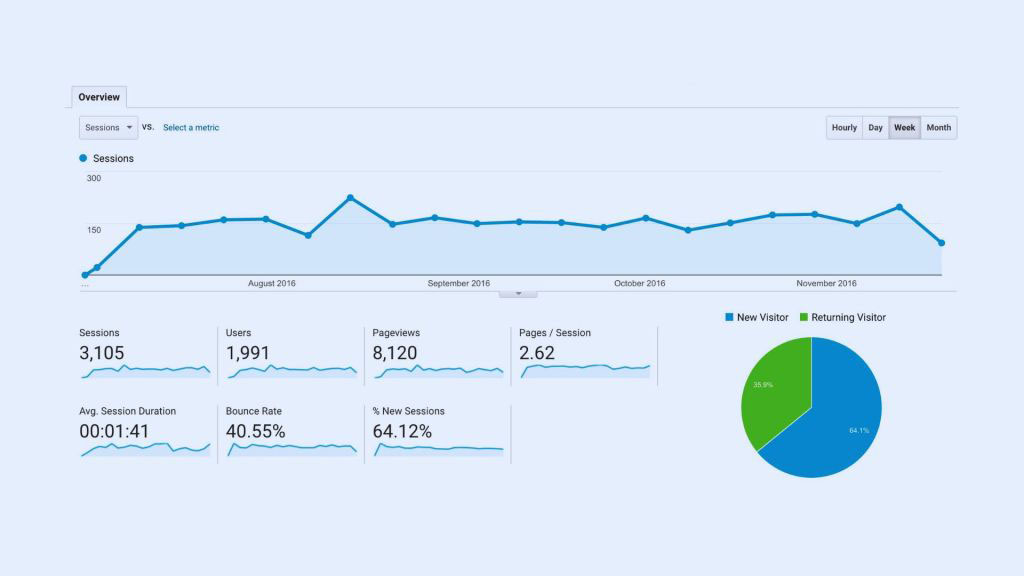Table of Contents
Imagine you built a fantastic restaurant, but people have yet to learn it exists. That’s the situation for many websites struggling with SEO. You might have incredible Content, but if search engines need help understanding your value proposition, you’ll miss out on a massive audience. This is where Google Analytics for SEO comes in. It’s not just a website traffic tracker; it’s a powerful tool to inform and optimize your SEO strategy. By analyzing user behavior and website performance, you can identify areas for improvement and climb the search engine rankings ladder.
Google Analytics for SEO: Unveiling the Secrets to Success
Google Analytics doesn’t directly control SEO ranking but provides invaluable insights that can significantly boost your organic traffic. Here are seven proven strategies to leverage Google Analytics for SEO:
Identify Your Top-Performing Organic Pages
It is crucial to understand which pages naturally attract visitors through search engines. Navigate to Acquisition > Search Console > Landing Pages . This report reveals which pages rank highest for specific keywords and generate the most organic traffic.
- Action: Analyze the Content and structure of these top-performing pages. Implement similar elements (e.g., keyword density, headings, internal linking) on other pages to enhance their SEO potential.
Discover High-Traffic, Low-Ranking Pages
Unearthing pages with high traffic but low organic ranking presents a golden opportunity. These pages are already attracting visitors, but they need SEO optimization.
- Action: Head to Behavior > Site Content> All Pages . Sort by “Unique Pageviews” to identify high-traffic pages . Then, use Google Search Console to check their organic ranking for relevant keywords. Target these pages for keyword optimization and on-page SEO improvements.
Analyze User Behavior and Engagement Metrics
User behavior tells a compelling story. Google Analytics provides a wealth of metrics to help you understand how visitors interact with your website. Look at metrics like:

- Average Time on Page: This indicates how engaging your Content is. Low time suggests visitors are bouncing quickly, displaying content improvement needs.
- Bounce Rate: the proportion of users that quit after only one-page view. A high bounce rate suggests landing pages need to meet user expectations.
- Exit Pages: Pages from your website that users exit. Analyze these pages to identify potential drop-off points and optimize them for a better user experience .
- Action: By analyzing these metrics, you can pinpoint areas that hinder user engagement. This might involve improving page loading speed, optimizing mobile responsiveness, or restructuring Content for better flow.
Leverage Organic Search Traffic Data
The Acquisition > Search Console section offers a treasure trove of SEO-related insights. Here’s what you can glean:
- Organic Keywords: Discover the keywords users employ to find your website. Focus on optimizing Content for these keywords while targeting relevant long-tail variations.
- Landing Pages: See which pages appear most often in search results for specific keywords. This helps you tailor those pages for even better ranking.
- Click-Through Rate (CTR): Analyze the CTR for your organic listings. A low CTR indicates your title tags and meta descriptions might not be compelling enough.
- Action: Use this data to refine your keyword strategy and optimize your website’s Content and structure for the keywords already driving traffic.
Track Conversions and Goal Completion
SEO isn’t just about website traffic; it’s about driving conversions, whether they’re purchases, sign-ups, or downloads. In Google Analytics, objectives are created to monitor these conversions.
- Action: Analyze which organic traffic sources lead to the most conversions. Focus on optimizing Content and user experience for those high-performing channels.
Monitor Mobile Usability
It is now necessary to have a mobile-friendly website because the majority of web searches are conducted on mobile devices.

- Action: Utilize Google Analytics’ mobile reports to assess your website’s performance on smartphones and tablets. Identify and address any mobile-specific issues hindering SEO and user experience.
Stay Updated with Google Algorithm Changes
Google’s search algorithm is constantly evolving. Follow Google’s Search Central blog and webmaster guidelines to stay informed about these updates.
- Action: Adapt your SEO strategy based on algorithm changes. Google prioritizes high-quality Content, user experience, and mobile-friendliness.
Keyword Research and Content Optimization: The Fuel for Organic Traffic
While Google Analytics provides invaluable data, you need the right fuel to run your SEO engine. This fuel comes in the form of well-researched keywords and optimized Content.
- Conduct Keyword Research: The cornerstone of every SEO campaign is keyword research. Use tools like SEMrush or Google Keyword Planner to find low-competition, high-volume, relevant keywords. Target a mix of head terms (broad keywords) and long-tail keywords (more specific phrases) to capture a wider audience.
- Optimize Content for Search Engines and Users: Identifying the most relevant keywords for your audience is the first step in improving your website’s exposure in search engine results and for human readers. This includes incorporating keywords throughout your Content, using relevant meta descriptions and title tags , and ensuring proper on-page SEO best practices like image alt text and internal linking. However, remember that SEO is not just about keyword stuffing. Focus on creating high-quality, informative Content that resonates with your target audience and provides value.
Embrace the Power of Internal Linking: Building a Strong Website Architecture
The deliberate arrangement of links within your website’s pages is known as internal linking. It enhances user navigation and aids search engines in comprehending the architecture of your website.
- Strategic Link Building: Don’t underestimate the power of internal linking. By linking relevant pages together, you distribute “link juice” throughout your website, boosting the SEO authority of all your pages. Pointing visitors to relevant Content that expands their comprehension of your services keeps them interested and facilitates search engines’ better crawling and indexing of your website.

- Create a User-Friendly Website Structure: A well-organized structure with a clear hierarchy is crucial for SEO and user experience. Strive for a flat architecture where most pages are within three clicks of the homepage. This ensures a smooth user journey and allows search engine crawlers to discover all your valuable Content efficiently.
SEO Optimization – A Journey, Not a Destination
Leveraging Google Analytics for SEO is an ongoing process. By consistently monitoring website performance, user behavior, and organic traffic data , you can make data-driven decisions to optimize your website for search engines. Keep in mind that SEO is a journey, not a sprint. These techniques will raise your website’s search engine ranks when applied diligently.
Understanding User Behavior: Utilizing Google Analytics for SEO Insights
If you want your website to perform better in search engine optimization , you must learn how users behave. It can enhance the user experience and increase search engine rankings with Google Analytics’s data. You can achieve this by basing your decisions on data collected from people’s interactions with your website.
- Page Views: Analyze the most viewed pages to understand what content resonates with your audience. This helps in creating more of what your users like.
- Session Duration: Track how long visitors spend on your website. Extended sessions frequently suggest that readers find your material interesting and pertinent.
- Behavior Flow: Consider the route that visitors travel on your website. This helps you determine popular content and possible drop-off places.
- Exit Pages: Determine which pages users leave to understand where your site needs improvements.
- User Demographics: Use demographic information to create content specific to your audience’s needs and interests.
By leveraging these insights, you can enhance your SEO strategy, ensuring your website meets the expectations of your users and search engines alike.
Bounce Rate Analysis: Enhancing User Engagement with Google Analytics for SEO
Your bounce rate is a valuable metric to keep an eye on since it reveals the percentage of visitors that leave your site after seeing only one page. A high bounce rate can signal that users are not finding what they are looking for, impacting your SEO performance. Google Analytics helps you analyze and reduce bounce rates to improve user engagement.
- Content Relevance: Ensure your content matches user intent. High bounce rates can occur when content is irrelevant to the visitor’s search query.
- Page Load Speed: Optimize your site for faster loading times. Slow pages often lead to higher bounce rates as users are impatient.
- Mobile Optimization: It should be easy for mobile users to navigate your website. Swiftly losing users is possible with a poor mobile experience.
- Clear CTAs: Use clear and compelling calls to action to guide users to other parts of your site.
- Internal Linking: Develop a solid internal linking plan to get users through more of your website’s pages.
Reducing bounce rates by improving these aspects can lead to better user engagement and higher SEO rankings.
Tracking Conversions: Maximizing ROI through Google Analytics for SEO

Monitoring conversions is crucial to determining how successful your SEO campaign is. You can set up and monitor different conversion objectives with Google Analytics, which gives you insights into how your SEO tactics encourage beneficial activities on your website.
- Goal Setting: Define clear conversion goals such as form submissions, purchases, or newsletter sign-ups.
- Funnel Visualization: Use funnel visualization to find development areas and see where people stop converting.
- Source/Medium Reports: Determine which traffic sources drive the most conversions, helping you focus your SEO efforts on high-performing channels.
- A/B Testing: Conduct A/B tests on landing pages to identify which versions drive higher conversion rates.
- E-commerce Tracking: Use e-commerce tracking to monitor sales and revenue generated from your SEO efforts for online stores.
By monitoring and evaluating conversions, you can fine-tune your SEO tactics to enhance your return on investment.
Demographic Insights: Targeting Your Audience with Google Analytics for SEO
Google Analytics demographic insights give you valuable details about the age, gender, and hobbies of people who visit your website. Creating search engine optimization strategies and content that resonates with your target audience needs this data.
- Age & Gender: Understand the age and gender distribution of your audience to tailor your content and marketing messages accordingly.
- Interests: Leverage interest categories to create content that aligns with the hobbies and preferences of your visitors.
- Geographic Location: Identify where your audience is located to optimize for local SEO and create region-specific content.
- Device Usage: Analyze device usage to ensure your site performs well across different devices, enhancing user experience.
- Custom Segments: Create custom segments to analyze the behavior of specific demographic groups and tailor your SEO strategies to their needs.
Utilizing demographic insights helps you create more personalized and effective SEO campaigns, ensuring you reach the right audience with the right content.
Real-Time Data: Staying Ahead of Trends with Google Analytics for SEO
Google Analytics real-time data enables you to keep an eye on visitor activity as it takes place on your website. Being able to make fast adjustments to your SEO efforts and stay ahead of trends is made possible by this instant feedback.
- Current Traffic: See how many users are on your site and which pages they view. This helps in understanding real-time engagement .
- Traffic Sources: Identify where your real-time traffic is coming from, whether it’s organic search, social media, or referral sites.
- Content Performance: Monitor which content resonates with users, allowing you to capitalize on trending topics.
- User Location: Track the geographical locations of your current visitors to optimize for regional trends and needs.
- Conversions: Watch real-time conversions to assess the immediate impact of your marketing campaigns and SEO efforts.
Ready to Unleash the Power of SEO? While Google Analytics equips you with valuable insights, implementing a winning SEO strategy requires a comprehensive approach. OCH , a creative digital marketing agency, offers a full spectrum of SEO services to help you achieve your goals.
FAQ
1.What is Google Analytics strategy?
Google Analytics is a web analytics service that provides numerous analytical tools useful for insights on website performance and marketing campaigns. Google Analytics is a web analytics service that provides statistics and basic analytical tools for search engine optimization and marketing purposes.



